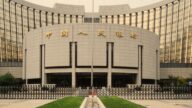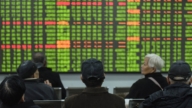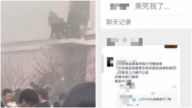【新唐人2013年09月09日訊】最近幾年,中國各銀行一直在大規模擴張信貸,用以刺激經濟增長和保持銀行業的高利潤。但隨著中國經濟增速的減緩,大陸銀行業越來越嚴重的「壞帳」危機日益凸顯出來。外界分析,中共在壞賬處理上已經陷入困局,很可能會再次增發貨幣,將壞賬轉嫁到普通百姓身上。
最近,中國四大銀行發佈報告聲稱,他們的上半年總盈利增長約12%。而上個月,中國銀行協會曾預測,中國17家上市銀行的淨盈利增長將從2012年的19%放緩到2013年的8%。
四大銀行的這一中期業績雖然略高於此前外界的預測,但絲毫無助於減少人們對中國銀行業充滿高風險的擔憂。
今年以來,上海上市銀行的股價指數下跌達9.1%,比上證綜合指數下跌7.6%的表現還差。而且,目前中國銀行股票是亞太地區最廉價的,在全球也位居第三最廉價,它的12個月前瞻市盈率為4.8,僅好於阿根廷和巴林。
英國《金融時報》中文網報導,自從2008年全球金融危機以來,中共當局出臺了一項大規模經濟刺激計劃,中國的信貸總量增長超過一倍。
國際著名評估機構高盛(Goldman Sachs)和摩根士丹利(Morgan Stanley)的分析師指出,如果算上銀行信貸、影子銀行系統融資、債券市場以及政府債務,中國的未清償信貸總額與GDP之比已經高達220%。
在剔除中央政府的直接借款之後,未清償信貸仍然達到了105萬億人民幣。如果按照中國在二十世紀九十年代末期20%的不良貸款率估算,這意味著壞賬規模達到21萬億人民幣,與GDP之比達40%。但當局公布的銀行不良貸款率甚至不足1%,只有大約5400億人民幣。這個數據完全忽略了影子銀行的存在,而中國不良貸款的真實狀況或許就埋在影子銀行這條巨大的暗溝之中。
北京師範大學MBA導師、經濟專欄作家段紹譯:「國有銀行的錢,也都是貸給了國有企業,等於是左手貸給右手。也就是說,一些企業還不起銀行貸款的時候,它並不會讓這個企業破產,還是把這筆壞賬一直掛著。」
《金融時報》報導說,關於中國銀行業,有兩個廣受認同的觀點。第一,中國銀行業的壞賬規模將使2008年的美國銀行業危機相形見絀。第二,中共當局處理壞賬問題的方式與其他政府不同。
上世紀九十年代末期,中國就曾通過一輪所謂的循環融資將四大國有銀行的大部分壞賬剝離出來,注入四家專門成立的所謂「資產管理公司」。
美國南卡羅萊納大學「艾肯商學院」教授謝田:「中共耍了一種手段,它用剝離的辦法把那些壞賬給剝離出來。把那些壞賬打包以後,兜售給了其他一些西方金融機構。華爾街這些金融公司實際上為中共輸血,幫助中共度過這個難關。」
美國南卡羅萊納大學「艾肯商學院」教授謝田表示,現在中國銀行業的壞賬問題又更大範圍的出現,而華爾街的金融公司自身也處境不佳,中共將很難重施故技。
謝田:「如果銀行壞賬的問題跟中國地方政府的地方債問題、還有房地產泡破問題,這些都連在一起,它們實際上本身也是聯繫在一起的。如果這些都連在一起爆發的話,那就會拖垮中國的金融體系和那些國有銀行。」
謝田強調,這樣的情況下,中共一定會通過增發貨幣來試圖化解危機,而這將直接促成通貨膨脹,也就是相當於:把壞賬的負擔再一次轉嫁到老百姓身上。
採訪/陳漢 編輯/李謙 後製/李智遠
More Money Printing Expected In China
In recent years, bank loans have continued to grow in China.
The Chinese Communist Party (CCP) has used it to boost
the economy and to maintain high bank industry profits.
In reality, China’s economy has slowed down,
and the banking sector has seen increasing debt.
Analysts say that the CCP has run out of
solutions to the banks’ bad debt problems.
They estimate that the regime might once again print
more money, to shift the burden to the Chinese people.
Recently, China’s big four banks released a report.
It claims that net income in the first half
of 2013 has increased by some 12%.
In July, the China Banking Association
predicted that net profit of China’s 17 listed
banks will go down to 8% from 19% in 2012.
The four banks’ interim performance
is slightly higher than previous forecasts.
Yet, it does not help ease public concerns
about high risks in China’s banking industry.
Since the beginning of 2013, share prices for China’s listed
banks have lost 9.1% on the Shanghai Stock Exchange.
In contrast, the Shanghai Composite Index dropped 7.6%.
Currently, China’s bank stocks traded at the lowest price
in the Asia-Pacific region, and third lowest in world rankings.
Reportedly, its forward price-to-earnings ratio for the next
12 months is 4.8, only higher than Argentina and Bahrain.
The UK’s Financial Times (FT) Chinese edition reports that,
Chinese authorities have announced a huge economic
stimulus plan, to cope with the 2008 global financial crisis.
The scheme has since doubled
China’s total amount of credit.
Analysts at Goldman Sachs and Morgan Stanley have
indicated China’s credit-to-GDP ratio has reached 220%.
The calculation takes into account bank credit, shadow
banking financing, bond markets and government debts.
Analysts said that excluding the central
authorities’ direct loans, China still has
105-Trillion Yuan of outstanding credit.
In the late 1990s, China’s non-
performing loan (NPL) ratio was 20%.
Using this figure, China has seen 21 Trillion Yuan
of bad debts, with bad debt-GDP ratio up to 40%.
In reality, China’s officially released bank NPL
ratio is below 1%, around 540 Billion Yuan.
FT says that China’s truth of bad loans may be
hidden by the unveiled giant shadow banking.
Duan Shaoyi, Economist: “State-owned commercial banks
have mainly loaned money to state-owned enterprises.
It’s like a loan transferred from the left hand to the right hand.
So, when some SOEs have defaulted
loans, the banks won’t let them go bankrupt.
The banks usually just write it off as bad debts.”
FT points out two widely accepted
views on China’s banking sector:
The size of bad debt dwarfs
America’s banking crisis in 2008.
Chinese authorities’ way of dealing with the
banks bad debts differs from other governments.
In the late 1990s, the CCP authorities wrote
off bad assets of the big four state-run banks.
The value was recorded as investment injected into four
specifically established “Assets Management Companies”.
Xie Tian, Professor at University of South Carolina-Aiken:
“The CCP used a trick to write off those bad debts.
It wrapped up the bad debts and sold
them to some Western financial institutions.
These Wall Street financiers have actually injected the
CCP with blood, and helped it to overcome the crisis.”
Xie Tian says that bad debt has
grown in China’s banking system.
Meanwhile, Wall Street financial institutions are ailing.
So, it is hard for the CCP to play the same trick again.
Xie Tian: “Chinese banks’ bad debt problems are connected
with issues of local government debt and real estate bubbles.
Once they break out all together, China’s financial
system and state-owned banks will collapse.”
Xie Tian forecasts that the CCP will increase
currency assurance to defuse the crisis.
This will directly lead to inflation, he warns.
In other words, bad debt burdens will
again pass on to ordinary Chinese citizens.

























